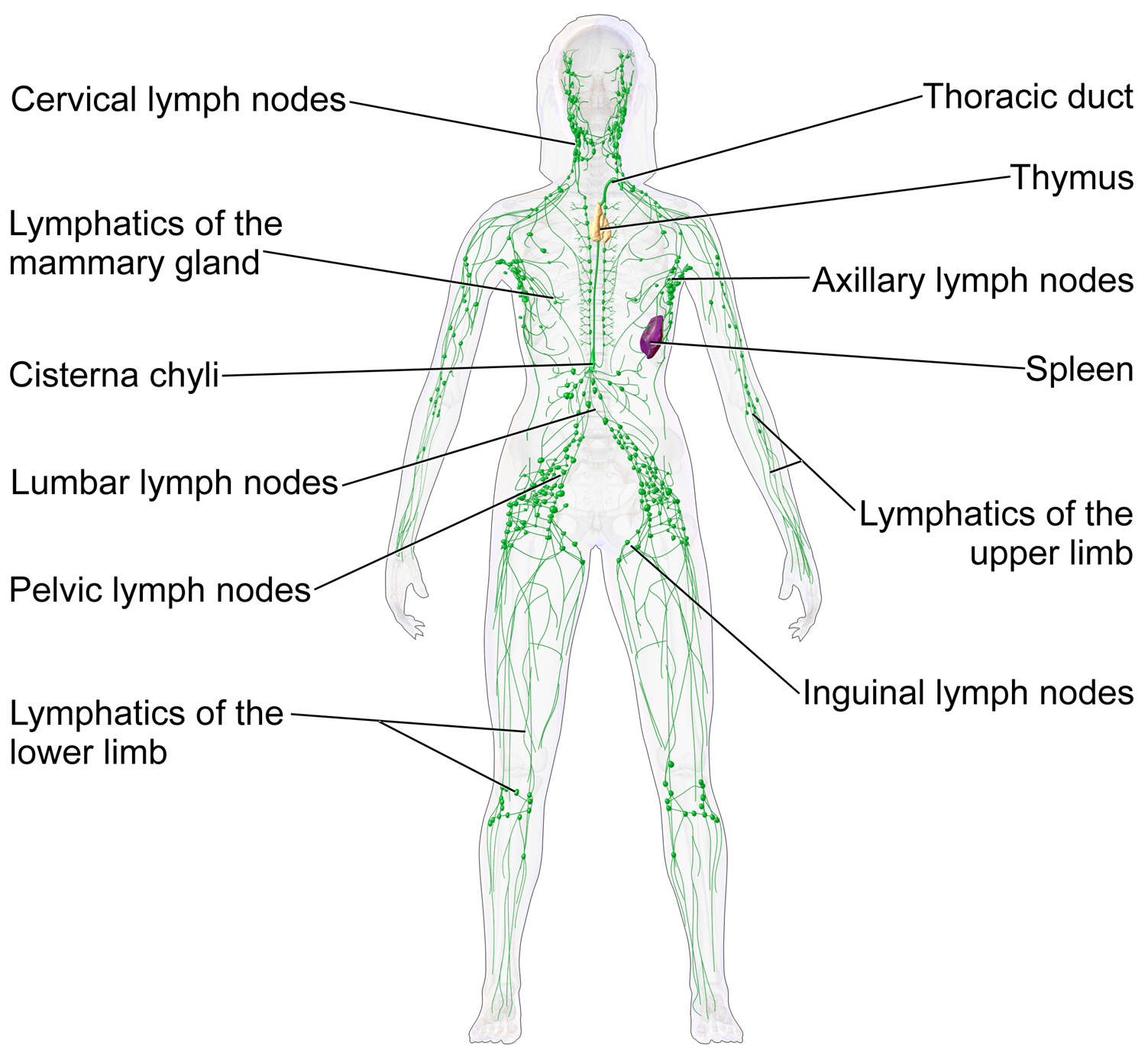
Often overlooked, the lymphatic system is an important system in the body. It plays a crucial role to support the cardiovascular system, the immune system, and the digestive system.
The lymphatic system includes a complex system of vessels, lymph nodes, and lymphoid organs (spleen, thymus, adenoids, tonsils). The lymph is a watery fluid that starts out as blood plasma squeezed out of capillaries around cells by blood pressure. The leakage allows the transfer of nutrients and waste between blood and cells. The capillaries on the venous end reabsorb some of the fluid, but a lot hangs around. The lymphatic system picks it up. The contraction of skeletal muscles during body movements helps force the lymph from interstitial spaces into the lymphatic system.
Once it’s been picked up by the lymphatic system, the lymph passes through lymph nodes. There are hundreds of lymph nodes in the body. They are clustered around specific areas of the body (under the armpits, around the groin, behind the knees). The lymph nodes are the filtering stations where the immune system inspects the lymph to sort out what’s friend and what’s foe. If the node is overwhelmed, it becomes inflamed. You can feel it under your skin; it feels like a little bump. The production of antibodies that can recognize past foreign invaders takes place in the lymph nodes.
The purified fluid flows to collecting vessels and finally into one of two big ducts which connect to the bloodstream near the collarbones. Unlike the cardiovascular system, the lymphatic system has no pump: smooth muscles contract to move lymph along through the vessels. Skeletal muscle contractions, pressure changes in the thorax during breathing, and the pulsations of adjacent arteries also help.
The lymphatic system plays a role in fatty acid absorption. The walls of the small intestine are covered with fingerlike projections called villi. The blood capillaries in the villi absorb most nutrients, but the fats and fat-soluble vitamins are absorbed by the lacteals, special lymph capillaries in the villi, because fat molecules are too big to be absorbed in the tiny blood capillaries. The lymphatic system transports the fat into the bloodstream.
To sum up, the main functions of the lymphatic system are:
- to return into circulation the fluid that has leaked from capillaries, thus maintaining proper fluid balance in the body
- to inspect the lymph, get rid of waste and pathogens, and produce antibodies, thus helping to fight infection
- to absorb fat and fat-soluble vitamins
What are the symptoms of a stagnant or congested lymphatic system?
- Chronic diffused pain
- Headaches
- Brain fog
- Lack of energy
- Low mood
- Constipation
- Intestinal Bowel Syndrome (IBS)
- Abdominal bloating
- Nausea
- Immune dysregulation
- Frequent infections
- Ear ringing
- Mucous
- Recurrent sore throats
- Inability to lose weight
- Soreness or stiffness in the morning
- Swelling in extremities
- Itchy skin
- Dry skin
- Lumps and growths
- Eye puffiness
- Vertigo
- Cellulite
What are the main causes of a stagnant or congested lymphatic system?
- Dehydration
- Lack of movement, sedentary lifestyle
- Stress
- Digestive and elimination issues
- Too many toxic chemicals
How do you keep your lymphatic system functioning properly?

- Practice deep diaphragmatic breathing several times a day. Inhale through the nose and make sure your belly is sticking out. Exhale through your mouth. The rib cage is a major lymphatic pump in your body. Deep breathing is crucial to increase lymphatic flow.
- Stay hydrated. Your lymph is 75% water. First thing when you get up in the morning, drink 1 big glass of water. Drink two big glasses of water 15 minutes before each meal.
- Move throughout the day. Stand up every half hour of sitting and stretch your body. Brisk walk 30 minutes a day; pump your arms and breathe deeply while walking. Do some resistance training two to three times a week. Anything that ramps up your heartbeat or that stretches and contracts your muscles will move your lymph.
- Use a rebounder. Rebounding involves jumping on a trampoline. Mini trampolines facilitate this practice at home. You can also do some gentle bouncing if you do not want to invest.
- Do some simple yoga poses such as spinal twists or legs up the wall.
- Don’t slouch. Sit up or stand up straight.
- Avoid tight-fitting clothes. Use loose, comfortable clothing.
- Try dry brushing. Take a dry sponge. Brush your skin towards the heart.
- Use hot and cold showers or hot and cold foot baths (30 seconds in cold water, 3 minutes in hot water). You can also simply do a cold flush at the end of your shower.
- Eat more fiber to avoid constipation and promote elimination.
- Limit toxic chemicals. Be wary of what you put on your skin. Eliminate fragrances.
- Find self-massage techniques for increasing lymph flow on YouTube. Do those techniques at least once a day.
